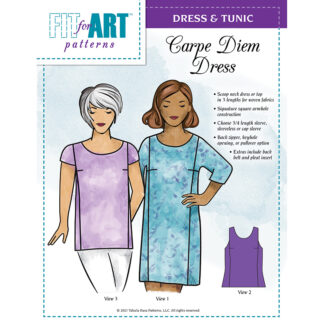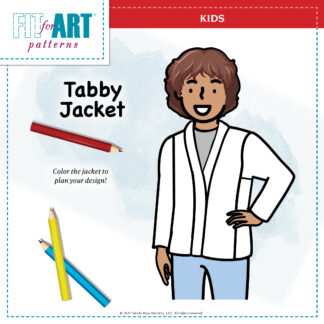
The Tabula Rasa Jacket is the perfect choice for garments made with handwoven fabric. Because it is Spinning and Weaving week at the Handweavers Guild of America we are bringing you a few tips from our Handwoven Tips Booklet. This featured vest was made and photographed to illustrate the planning and construction of a handwoven Tabula Rasa Vest.

Sew Loosely Woven Fabric Successfully
Like many handwovens, the black silk remnant used to make this vest was narrow and inclined to fray out before, during and after it was stitched into a garment. Because I know this little vest is going to get lots of use, in every season of the year, I constructed it with care and attention to the special needs of handwoven fabrics.
The project began with a 1 yard length of 38” wide fabric. The label said 40” but after it was pre-washed, it measured between 38 and 39”. The light weight tweedy silk handwoven came from the clearance basket at Mekong River Textiles. Initially we thought it would mix with other fabrics in our stash, but the greys and whites really did not look good with other fabrics on hand. A short vest seemed like an excellent default option. The vest directions for the Tabula Rasa Jacket pattern are a free download on our website.

Sketch your Ideas First
As you see from my sketches, I was playing with the idea of two layers and/or a flange addition at the shoulder line. A quick assessment of the fabric with my personalized pattern pieces in hand eliminated the double layer idea, but I found it possible to cut single layer flanges along the selvage. Using handwoven selvages is so interesting in a garment because they are so very textural.

Cut the Fabric, Lining, and Interfacing
In addition to cutting out the handwoven fabric, I cut a poly-cotton broadcloth lining. It adds weight to the vest and securely captures all the seam allowances and interfacings inside the garment.
Once I cut the fabrics, I cut 1” strips of soft fusible interfacing to fuse into the seam allowances of the vest. Because the fabric was both white and black, after testing both colors I chose to interface in white so you would be able to see how the interfacing works in the garment. I used Soft Stretch interfacing which is perfect for handwovens; we sell it in interfacing samplers or by the yard.
The strips of interfacing fused to the seam allowances gives support to the garment in many ways without stiffening up the entire vest. Observe that I zigzagged the interfacing to the seam allowance so it will remain secure over time. My handwoven garments have worn beautifully over the years using this technique.
Add some Interesting Design Features
The entire front band is interfaced, too, so it will remain stable and support the button and loop closure. The front band is 1½” wide to repeat the width of the shoulder flanges. There is lots of information about this and similar closures in the Band Variations for the Tabula Rasa Jacket pattern which can be purchased as a downloadable pattern.
I am delighted by the perky look of the selvage edged flange. It adds a nice balance to the cropped shape of this vest. Watch this week’s Instagram and Facebook feed for step-by-steps photos of inserting the flange into the square armhole.
Keep Loosely Woven Seams Covered Neatly
The cotton lining was constructed then attached to the vest along the hemline by machine and flipped up into the inside of the vest. The front band captures all the raw edges of the jacket and lining. The armhole lining and inside front band were finished by hand as it offers the stitcher more control and a lovely finish.
Get Ready to DIY Your Own Jacket
If you are a member of the HGA, place a $50 order in our online store and remind us in your note to include your free copy of Tips for Handwoven and Handcrafted Fabrics for the Tabula Rasa Jacket. Pick up several yards of our fine interfacings to complement your Tabula Rasa Jacket and Jacket Variation patterns.
We invite you to take a look at the beautiful Greater Baltimore Weavers Guild online exhibit where you will see two very beautiful Tabula Rasa Jackets made by some very talented weavers. If you want to read more about handwoven TRJ’s check out these archived blog posts: Weaving Together Connections, Traveling to Sew, and Handmade Birthday Gift.
Stay Well and Sew Happy, RAE











